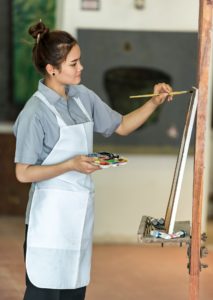- Calls to this hotline are currently being directed to Within Health or Eating Disorder Solutions
- Representatives are standing by 24/7 to help answer your questions
- All calls are confidential and HIPAA compliant
- There is no obligation or cost to call
- Eating Disorder Hope does not receive any commissions or fees dependent upon which provider you select
- Additional treatment providers are located on our directory or samhsa.gov
Creative Arts Therapies in the Treatment of Co-Occurring Disorders

Contributor: Rachel Wagner-Cantine, LCPC, BC-DMT, Mood Program Coordinator and Dance/Movement Therapist, Timberline Knolls Residental Treatment Center
Although co-occurring disorders may manifest differently and require different diagnostic criteria, ultimately, they are interrelated. The disorders stem from a deeper dissonance or conflict.
Whether a past traumatic experience, a disrupted attachment, or an emotional imbalance, the symptoms and behaviors become the outward expression of the inward pain and struggle.
Traditional talk therapies and behavioral interventions are useful in effectively decreasing and managing the symptoms and/or behaviors; however, they may not be enough to resolve the inner conflicts as well as the disconnect that often occurs between mind, body, and emotion.
The Power of Creative Art Therapies
When words are not enough, the creative arts therapies can be a useful tool for self-expression, self-discovery, and regulation. Through art, dance/movement, music, drama, and poetry, a new experience of therapy can be achieved. The creative process can help to expand and deepen the therapeutic process by tapping into the organic, unfiltered parts of one ’s self.
Those struggling with mental illness are often skilled at wearing masks, smiling through the pain, or putting on a happy face. When we connect with the nonverbal, creative parts of ourselves and our diseases, it is often more difficult to maintain the façade.
The expressive modalities mentioned above can assist in helping to regulate during emotional distress, helping the individual to get through the wave of emotions in a safe fashion. This could be through journaling, painting, and drawing, going for a walk, stretching, dancing, singing, playing an instrument, or listening to music.
Therapeutic Benefits of Expressive Actions
While these expressive actions are very therapeutic, when does the use of creative arts become therapy? The key to this approach is the combination of expressive arts and verbal processing. The nonverbal and verbal combination assists in illuminating the inner dissonance or conflict and making connections between how this is outwardly displayed in symptoms or behaviors.
Questions such as these should be posed:
- “As you talk about your hurt and pain within a past relationship, what do you notice in your body?
- What does your struggle look like?
- Does it have a color or an image?”
In addition, creative arts therapies help to focus on present-moment experiences by honing into body sensations and creative impulses.
Psychiatric disorders are multifaceted and complex diseases. Therefore, it is important to use every available therapy to help people obtain and sustained recovery.

Rachel received a bachelor of fine arts degree in dance from the University of Illinois and a Master’s degree in Dance/Movement Therapy and Mental Health Counseling from Columbia College in Chicago.
The opinions and views of our guest contributors are shared to provide a broad perspective of eating disorders. These are not necessarily the views of Eating Disorder Hope, but an effort to offer discussion of various issues by different concerned individuals.
We at Eating Disorder Hope understand that eating disorders result from a combination of environmental and genetic factors. If you or a loved one are suffering from an eating disorder, please know that there is hope for you, and seek immediate professional help.
Reviewed By: Jacquelyn Ekern, MS, LPC on January 15, 2017.
Published on EatingDisorderHope.com

